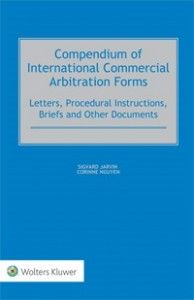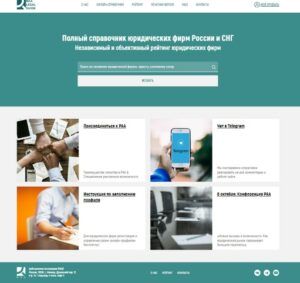A Compendium of International Commercial Arbitration Forms Helpful Both for Arbitrators and Parties
 Book reviewed: Sigvard Jarvin, Corinne Nguyen. Compendium of International Commercial Arbitration Forms. Letters, Procedural Instructions, Briefs and Other Documents. Wolters Kluwer. 2017. 612 pages
Book reviewed: Sigvard Jarvin, Corinne Nguyen. Compendium of International Commercial Arbitration Forms. Letters, Procedural Instructions, Briefs and Other Documents. Wolters Kluwer. 2017. 612 pages
The authoritative legal publisher Wolters Kluwer produced a compendium of English-language forms intended for use in international commercial arbitral proceedings.
The compilers of the compendium are Sigvard Jarwin, a well-known international arbitrator, and Corinne Nguyen, a French lawyer, a former member of the Secretariat of the International Court of Arbitration of the International Chamber of Commerce (ICC). Practitioners made the compilation for practitioners: arbitrators, rapporteurs, secretariat staff of arbitral institutions and the parties’ representatives.
Old vs. modern arbitration
Initially, commercial arbitration presupposed an extremely informal procedure: it was similar to an old English court, called “court of pied-powder”, where the judges had to resolve the dispute between traders in the market so quickly that the dust had not yet managed to fly off the shoes of the disputants.
Modern arbitration much differs from this: it often involves an exchange of detailed written documents between the parties and the arbitral tribunal. The preparation of such documents often takes considerable time. Meanwhile, many questions remain typical for various arbitral proceedings. This makes it expedient to develop and, in appropriate cases, to use the forms of various procedural and other documents, including the structure of the statement of claim, withdrawal of the claim, procedural decisions of the arbitrators, and so on.
Sigvard Jarwin and Corinne Nguyen prepared a compilation of such forms and other documents, with their comments attached. These forms may be of interest to a great number of participants in international arbitral proceedings from Russia and other CIS countries, including both beginners and experienced arbitrators, as well as representatives of the parties.
online pharmacy https://shop.fargoderm.com/wp-content/themes/twentysixteen/inc/new/albuterol.html no prescription drugstore
This can improve the effectiveness of arbitration and reduce the costs of drafting procedural documents. At the same time, the use of these forms does not appear to be mechanical: they often need adaptation to the peculiarities of a particular case.
The scope of the compendium: procedural documents featuring ICC
The documents cover a wide range of issues with regard to different arbitration rules. As follows from the introduction to the compendium, the authors sought to include in the compendium most typical and representative for each type of procedural documents, without affecting the issues of substantive law. They set the task to take into account the differences in approaches to international arbitration existing between lawyers from the common law and continental law countries.
The drafters largely fulfilled the task set for themselves. Notably most of the forms present in the compendium take roots from arbitration under the Rules of the International Chamber of Commerce. For example, they include a document called “Terms of reference”, not provided for by many other arbitration institutions.
Documents compiled according to the regulations of a number of other authoritative international arbitral institutions do not appear in the compendium. This, apparently, results from the professional experience of the drafters, whose arbitration practice centres, first of all, on the ICC arbitration.
Keys to resolve topical issues at every stage of arbitral proceedings
The compendium covers all the main stages of arbitral proceedings: from the claimant’s request for arbitration till the arbitral tribunal’s final award.
In particular, it contains examples of the request for arbitration and the options for answering it, statements by arbitrators about disclosure of a conflict of interest, representative’s powers of attorney. It also comprises documents designed to organize the arbitral procedure, including the procedural timetable. In addition, one can find forms of documents for the multi-party proceedings.
The book also contains options of resolving typical questions that arise in the course of arbitration, including the procedure for the submission and processing of documents by the parties, the determination of their number, witnesses examination, and the actions after the hearing on the merits of the dispute. In particular, one can see the Redfern Table with examples of its application, as well as texts for documenting parallel proceedings and “bifurcation” of the arbitration.
Such materials largely complement the provisions of arbitration rules, introducing additional certainty into the procedure.
Also in the compendium, there are examples of statement of claim, statement of defence and counterclaim; requests of the parties for interim measures and an example of the relevant decision of the arbitral tribunal.
As for the stage of hearing the case, one can find examples of the hearing agenda, opening and closing statements of the parties. Also of interest is a preliminary opinion of the arbitral tribunal on the merits of the dispute with a view to facilitating reconciliation of the parties. It seems that such preliminary opinion is appropriate only in case of a direct request from the parties unless otherwise follows from the applicable law and the provisions of the arbitration rules.
Finally, the compendium contains sample statements by the parties regarding arbitration expenses, the form of the arbitral award on the merits and the consent award; partial and interim award; applications of the parties on the termination of arbitral proceedings. There is an example of the decision of the arbitral tribunal regarding the distribution of arbitration costs, including where a party by its actions contributed to their unreasonable increase.
online pharmacy https://shop.fargoderm.com/wp-content/themes/twentysixteen/inc/new/orlistat.html no prescription drugstore
The index and a table of contents help to orient in the compendium.
Forms mostly for large and complex arbitrations, but not only for them
Undoubtedly, it is convenient that the forms of documents used in international commercial arbitration are systematized and combined in one compendium. Reliance on forms helps to save time by using standard, elaborated texts, and structures. Also, the materials of the compendium are of interest as a reminder for questions that need to be addressed by arbitrators or parties in their procedural documents.
First of all, one can use the relevant sections of the compendium in international arbitrations conducted in English, which is not unusual for the proceedings at the ICAC at the Russian Chamber of Commerce and Industry. However, its content can be useful in arbitration (both institutional and ad hoc), conducted in one of the other languages, including in Russian (through translation and adaptation).
It seems that many of the materials of the compendium best suit, first of all, sufficiently large and complex international arbitral proceedings. Its materials can be useful for proceedings under the rules of various arbitration institutions, including the ICAC and the Maritime Arbitration Commission at the Russian Chamber of Commerce and Industry.
The proposed forms help to standardize international arbitration, which in turn might improve the quality of the arbitral procedure.
online pharmacy https://shop.fargoderm.com/wp-content/themes/twentysixteen/inc/new/prednisone.html no prescription drugstore
At the same time, the quality of the procedure depends both on the degree of satisfaction of the parties, and the prospect of the courts’ proceedings on enforcement of the arbitral awards.
Texts to be thoughtfully adapted for each particular case
At the same time, each arbitral proceedings has its own individual character, which is determined by the nature of the subject matter of the dispute, the characteristics of the parties, their representatives and applicable law. In this regard, the use of documents present in the compendium requires reflection and must meet a balanced and creative approach.
One can apply materials of the compendium both in current arbitral proceedings (according to the rules of permanent arbitral institutions and in ad hoc arbitrations, for example, under the UNCITRAL Arbitration Rules), and for further improvement of the institutional rules and practices of arbitration.
Alexey A. Kostin, Professor, Chairman of the ICAC and the Maritime Arbitration Commission at the Russian Chamber of Commerce and Industry
Dmitry Davydenko, PhD in Law, Executive Secretary of the Maritime Arbitration Commission at the Russian Chamber of Commerce and Industry, Director of CIS Arbitration Forum











